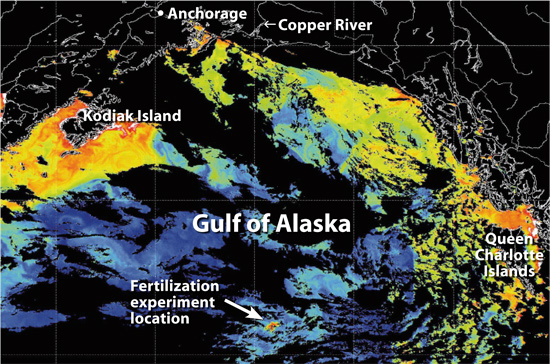Fertilizing the Oceans
 Michael Markels makes the economic case for fertilizing the oceans:
Michael Markels makes the economic case for fertilizing the oceans:
If fertilizer costs $200 to $400 per ton when applied to the ocean surface, the estimated annual cost is $50 million to $100 million for the application of 250,000 tons. A $100 million per year experiment fertilizing 53,000 square miles of the Gulf Stream may not be the minimum-size experiment needed to demonstrate the possibilities of open ocean farming.I find his numbers a bit on the high side, but even when adjusting them with more realistic numbers, it still looks like a profitable venture.
Ocean farming of the Gulf Stream along the Atlantic Coast of the United States could increase that area’s phytoplankton, the base of the food chain, by a factor of about one thousand—to a billion tons per year by bringing the productivity up to the level that occurs naturally off the coast of Peru. That could increase the fish catch by a factor of 400—from 125,000 to 50 million tons per year. At 40¢ a pound for fish, that would be worth $40 billion per year. The increase in both catch size and value would be about 10 times the total 1993 values for the United States and about one half the total 1992 world catch.
The estimate of the current level of phytoplankton production is about 7 million tons for the Gulf Stream from Key West, Florida to the Outer Banks of North Carolina. (That figure is only about 0.7 percent of the one billion tons that could be expected from fertilization, which would be 143 times normal production.)
Nutrient-rich ocean can produce 40 tons of biomass per acre per year. This is the same level of productivity as for sugar cane cultivation on land: 25,600 tons per square mile per year.
This fact cuts the productivity of fertilizer more, conservatively figuring, to 4,000 pounds of biomass per pound of fertilizer in the Gulf Stream.
He assumes 4,000 lbs of plankton per lb of fertilizer. Based on 12 experiments, 1 ton of iron led to 1,000 tons of additional carbon being taken up by plankton. GreenFuel assumes that algae is slightly over 50% carbon by weight, and assuming this ratio holds for plankton that would mean 1,000 tons of carbon translates to 2,000 tons of plankton.
He assumes that for every 100 tons of additional plankton, an additional 5 tons of fish will be caught, or 20 lbs of plankton per lb of fish. I don't really understand how he comes to this number. It looks like he believes there would be 25 tons of fish per 100 tons of plankton and then he decides to be conservative by dividing that number by 5. Instead, I would assume that the average trophic level of the catch would be 3.5, and that it takes 10 tons of mass to create 1 ton of a higher trophic level fish. This would mean it takes 10^3.5 = 316 lbs of plankton to make one lb of fish at a 3.5 trophic level.
Google Docs Spreadsheet
Per dollar spent on fertilizer, he concludes that there would be $100 of fish. I come to a number of $3.16 (I assumed his prices for fertilizer and fish were accurate). This gives a very high return on investment and is justified economically.
If the numbers work, then why hasn't this been attempted? The problem here lies in the fact that the person who pays for the fertilization is not likely to reap the benefits of the increased fish yield. One possible way to solve this problem is for the US government to pay for the fertilization with US citizens gaining the benefit. This is unfair to those citizens who do not consume fish, so a second way this could be accomplished is if there was an association of fishermen on the east coast who came together to jointly fund this and jointly share in the rewards (possibly with a loan from the US government to start it out). Another way would be to assign property rights to either the ocean itself or the catch of the fish. This would allow the person who paid for fertilization to own the increase it fish that it caused and gain the financial reward.
Other ventures such as Climos and Planktos Science are looking to fertilize the ocean, but are doing so as a way to sequester carbon. I think the economics of this make more sense as a way to increase fish yield, especially at a time when food prices are greatly increasing.





No comments:
Post a Comment
Note: Only a member of this blog may post a comment.